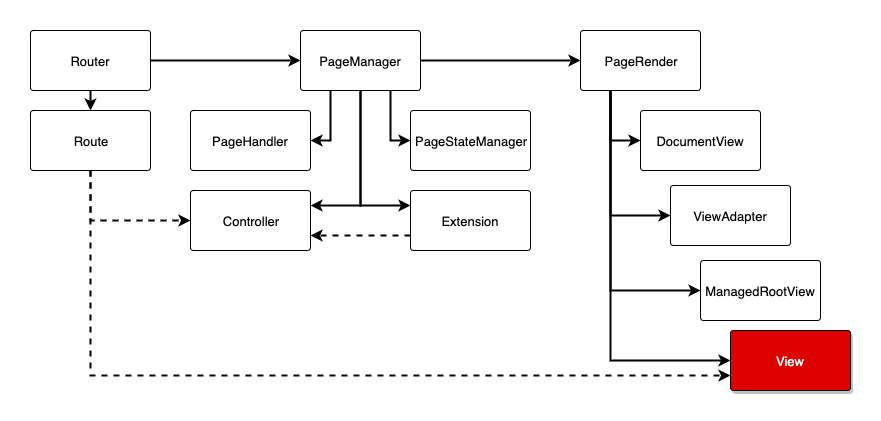-
Notifications
You must be signed in to change notification settings - Fork 3
Views & Components
- Organizing Views
- Rendering Views
- Communication between Views and Controllers
- Utilities shared across Views and Components

As you may have noticed when a route is registered, a constructor of Controller and View is given as a 3rd and 4th argument. Controller takes care of loading and managing the data while View is a presentation for the data loaded by the Controller.
A good spot to place a view file is next to a controller file - that is:
app/page/<name-of-the-page>/
├─ SomeController.js
├─ SomeView.jsx
└─ someView.less
To structure your views easily you can split your views into a smaller components
that can also be reused in other views. Those smaller component are then included
and used as any other react component. Components should be
placed into a app/component/ directory.
app/page/component/
├─ document/
| └─ DocumentView.jsx
├─ header/
| ├─ Header.jsx
| └─ header.less
└─ searchBar/
├─ SearchBar.jsx
└─ searchBar.less
Views are just a React components that receive page state as props, that means you can freely use internal component state and any React lifecycle methods as you wish.
An element that is returned from the render method is appended to the
ManagedRootView, ViewAdapter and then DocumentView on the server side
and send as a plain HTML markup to the client where it's hydrated with it's
former state.
When a route change occurs on a client side and...
- ...only route parameters has changed, route was registered with the
onlyUpdateflag set totrueand Controller hasupdatemethod defined. In this case the View receives new props (page state) and should react to them accordingly. - ...the current view is different from the new one then the rendered view is replaced with a newly rendered view.
In ideal case Views should only display data loaded in Controller and not even
care about route parameters. But as nothing is ever ideal we've added params
object to the View props for you.
// app/config/routes.js
router.add('user-detail', '/user/:userId', UserController, UserView);
router.add('user-edit', '/user/:userId/edit', UserEditController, UserEditView);
// app/page/user-detail/UserView.jsx
const { userId } = this.props.params;
const userLink = this.link('user-edit', { userId });
<a href = { userLink }>
This example ensures that the link to user-edit page is functional
immediately when a user navigates to user-detail page. Otherwise the link would
be functional only after the user-loading promise has been resolved.
It's clear that data obtained in a Controller are passed down to a View and thus affecting how the rendered View looks and what it displays. A problem arises when a View wants to tell Controller to load or change something. The solution to this are event handling utils EventBus and Dispatcher.
At some point you'll come to a situation when it'd be nice to have a function or set of functions shared between multiple components. Great example would be custom link generation, page elements manipulation (modal, lightbox) or adverts and analytics.
These cases are covered by ComponentUtils that allow you to register classes (utilities) that are then shared across every View and Component. Utilities are instantiated through OC therefore you can get access to other utilities or IMA.js components.
Example Utility class would look like this. Simple class with dependency injection.
// app/helper/LightboxHelper.js
import Router from 'ima/router/Router';
export default class LightboxHelper {
static get $dependencies() {
return [Router];
}
showLightbox(content) {
...
}
}Then to register the utility class:
// app/config/bind.js
import ComponentUtils from 'ima/page/renderer/ComponentUtils';
import LightboxHelper from 'app/helper/LightboxHelper';
import AnalyticsUtils from 'app/helper/AnalyticsUtils';
export default (ns, oc, config) => {
const ComponentUtils = oc.get(ComponentUtils); // or oc.get('$ComponentUtils');
ComponentUtils.register('Lightbox', LightboxHelper);
// OR to register multiple utilities at once
ComponentUtils.register({
Lightbox: LightboxHelper,
AnalyticsUtils
});
};Finally, what'd be the point to register these classes if we were not to use them... All of the utilities are present in utils property on AbstractComponent.
// app/component/gallery/Gallery.jsx
import AbstractComponent from 'ima/page/AbstractComponent';
export default class Gallery extends AbstractComponent {
onPhotoClick(photoId) {
const { Lightbox } = this.utils;
Lightbox.showLightbox(...);
}
}For some heavy-used utilities we've created a shortcut methods in AbstractComponent.
-
link(name, params)= Router.link() -
localize(key, params= Dictionary.get() -
fire(eventName, data)= EventBus.fire() -
listen(eventTarget, eventName, listener)= EventBus.listen() -
unlisten(eventTarget, eventName, listener)= EventBus.unlisten()
One special case would be cssClasses shortcut which is by default alias for classnames package. You can overwrite this behaviour by registering you own helper in ComponentUtils under $CssClasses alias.
-
cssClasses(classRules, includeComponentClassName=this.utils.$CssClasses()
- Introduction
- Static view
- Adding some state
- Fetching the data from the server
- Writing posts
- Final polish